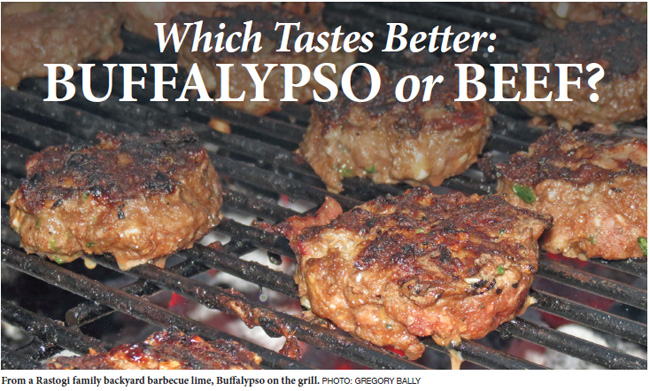 |
 |
 |
|
April 2018
|
In the sixties, Buffalypso designer, Dr. Steve Bennett had written that, “Ever since I can remember, buffaloes have been slaughtered in the abattoirs and sold in the market without discrimination as beef – yet many Trinidadians do not realize this fact and, if asked whether they have ever eaten buffalo meat, would reply that they have not, although they have probably consumed it unknowingly on several occasions.” Someone who once had a herd of Buffalypso in its heyday, recalled its characteristics. “It is different from beef, less fatty and very red in colour. The taste is slightly milder than beef, if barbecued. It’s been twenty years since I last ate it,” he said. He said that the younger animals, and those that have been properly fed, “produce good quality meat at a lower price than bovine animals.” In the early days, as Dr. Bennett was refining the Buffalypso to get more meat out of it, taste was also an important factor in trying to persuade others of the potential for a meat industry. In 1961, Dr. P.N. Wilson, published an article in the Journal of the Agricultural Society of Trinidad, “Palatability of water buffalo meat,” describing tasting sessions he had conducted. “In taste-panel studies in Trinidad, cooked joints from three carcasses Trinidad buffalo, a crossbred steer (Jamaica-Red/Sahiwal), and an imported carcass of a top-grade European beef steer-were served. The 28 diners all had experience in beef production, butchery, or catering and were not told the sources of the various joints. All the carcasses were held in cold storage for one week before cooking. The buffalo meat was rated highest by 14 judges; 7 chose the European beef; 5 thought the crossbred beef the best; and 2 said that the buffalo and crossbred were equal to or better than the European beef. The buffalo meat received most points for color (both meat and fat), taste, and general acceptability. There was little difference noted in texture.” Dr Bennett, had written of the purpose of these tasting sessions for the Caroni Limited Bulletin of 1964. “To popularize this meat and unbiasedly test its acceptance, Professor Peter Wilson of the University College of the West Indies, some years ago, sponsored several palatability dinners. At the first one he invited about forty-odd people who included several caterers from leading hotels, including those from the Trinidad Hilton, Farrell House, Bel Air and others.” Describing a session held under similar conditions, Bennett wrote, “The gourmets were given a card, not knowing what meat they were eating and asked to score points according to flavor, fat, etc. The buffalo beef won hands down on all scores.” More than fifty years later, even as the meat industry never took off, the Ministry of Food Production came up with another idea to promote the Buffalypso as an indigenous meat to be served at top restaurants. In 2014, Mrs Leela Rastogi, on behalf of the Ministry of Food Production, sent some meat to Chef Joe Brown (Jaffa’s) and to Chef Khalid Mohammed (Chaud), asking them to prepare some dishes with the Buffalypso so that the public could sample its diversity. The “Newsday” reported that “The tasting menu on the evening of September 26 included tartar, meat balls, sliders (mini burgers), kebabs, BBQ style home-smoked Brisket and Rib-Eye Roast.” It was curious timing, because at this point, the Government’s herd was already heavily infected with Brucellosis and the numbers had fallen drastically. The Minister of Food Production, Devant Maharaj, was interviewed by “Newsday”, telling them that “the relatively small size of the herd; between 900 and 1,200 head, means the Ministry cannot yet supply buffalypso meat to the general population on a regular basis.” This he said was the rationale for marketing the meat to the premium restaurants. The report went on, “Hence the decision to “market the meat to ‘premium’ restaurants.” Another, equally important reason, for doing so is that the herd is “grass-fed, organic-fed” on acreage in the Mora Valley in the Tableland area of south Trinidad. “This adds to the healthy component of the meat because grass-fed buffalypso is not only a leaner red meat than beef, it has fewer calories,” Maharaj pointed out. “It’s therefore a premium meat and we have to market it as such to restaurants with a clientele who can afford it.”\ Chef Brown was noncommittal in the report, saying that customers could call to find out whether or not he has Buffalypso. I tried to reach both chefs for their assessment of buffalypso meat. Chef Mohammed said, “I found the meat to be good for stewing, braising, etc. but not for roasting or grilling as it was tough.” But he would be willing to give it another shot. “I will definitely be interested in using it as I always prefer to use local products where I can, and I think it will be very interesting to our foreign and local customers,” he said. |


 Many people will tell you they have never even heard of Buffalypso, far less tasted its meat. In Trinidad and Tobago, far more people may have tried it than even they realise.
Many people will tell you they have never even heard of Buffalypso, far less tasted its meat. In Trinidad and Tobago, far more people may have tried it than even they realise.